Explore Dien Bien - North Vietnam Travel, Asia
Located in the heart of Northwest Vietnam, Dien Bien is a destination that invites travelers to step back in time while embracing the rich culture and breathtaking landscapes of the region. Known primarily for its pivotal role in the First Indochina War, Dien Bien has grown into a compelling tourist destination. Here, the echoes of history resonate through the lush valleys and towering mountains, offering visitors a unique blend of historical significance, cultural diversity, and natural beauty. From the iconic Dien Bien Phu Battlefield to the vibrant traditions of local ethnic minorities, this region promises an enriching journey for those eager to explore the lesser-known corners of Vietnam.
Population: Approximately 635,000 in 2022.
Economy: Dien Bien's economy is driven by agriculture, with rice and maize as key crops. Tourism also plays a growing role, highlighting its rich history and scenic landscapes, contributing to local development.
Landmarks: Famous for the Dien Bien Phu Battlefield, Muong Thanh Valley, and A1 Hill and The Museum of Dien Bien Phu.
Vietnam
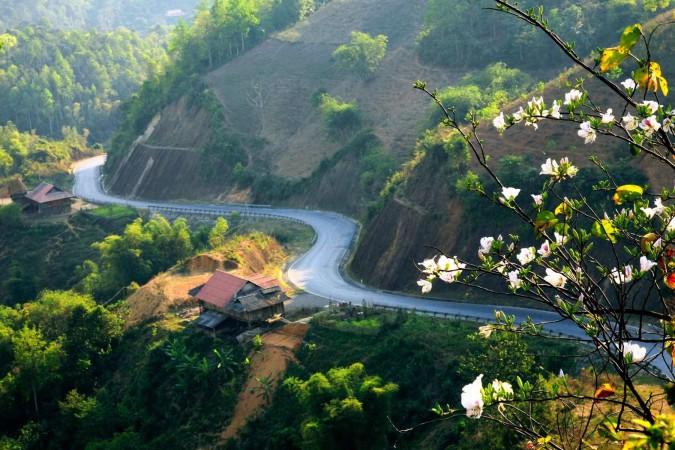
Overview of Dien Bien
History & Cultural Influence
Dien Bien Phu is more than a name in history books; it is the site where one of the most decisive battles in modern history took place. The Battle of Dien Bien Phu in 1954 marked the end of French colonial rule in Vietnam and heralded the rise of Vietnam as a sovereign nation. Today, the battlefield stands as a powerful symbol of resistance and resilience, drawing visitors who wish to pay their respects and learn about this crucial chapter in Vietnam’s history.
Beyond its historical legacy, Dien Bien is a cultural melting pot. The province is home to over 20 ethnic groups, with each group contributing to the region's rich tapestry of traditions, languages, and lifestyles. Whether through traditional music and dance, local handicrafts, or the unique culinary traditions of each ethnic group, Dien Bien offers a rare opportunity to engage with Vietnam’s cultural heritage in an authentic and meaningful way.
Interaction with The Locals
Dien Bien is home to a diverse population of around 635,000 people, made up of over 20 different ethnic groups. The Thai, Hmong, and Lao communities are the largest, each with their own distinct languages, traditions, and cultural practices. The people of Dien Bien are known for their warm hospitality and strong sense of community, deeply rooted in their ethnic heritage. This diversity enriches the province's cultural landscape, making it a vibrant place to explore and experience authentic Vietnamese traditions.
The Vietnamese have always been known for their friendliness and hospitality. Enjoy the unique premium experience of connecting with the locals in our Vietnam tours here.
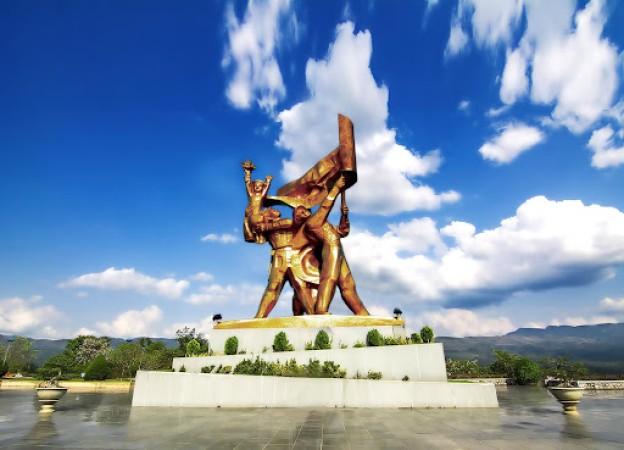
Dien Bien Phu Victory statue in Dien Bien - © VTV
Top Attractions in Dien Bien
Dien Bien Phu Battlefield
For history buffs, the Dien Bien Phu Battlefield is a must-visit. This historic site is where the Vietnamese forces, led by General Vo Nguyen Giap, achieved a monumental victory over the French in 1954. The battlefield, now a peaceful area surrounded by mountains and rice paddies, is a place of reflection. Visitors can explore the various sites, including the command bunker of the French forces and the memorials dedicated to the soldiers who fought here.
Muong Thanh Valley
Dien Bien’s natural beauty is as compelling as its history. Muong Thanh Valley, with its lush green fields and scenic mountain views, offers a serene escape into nature. The valley is often called the "rice bowl" of Dien Bien due to its extensive rice paddies, which create a stunning patchwork of green during the growing season. Visitors can take leisurely walks or bike rides through the valley, soaking in the tranquil atmosphere and picturesque landscapes.
Pa Khoang Lake
If you’re looking for a peaceful retreat, Pa Khoang Lake is the perfect destination. Located just outside the city of Dien Bien Phu, this large, clear lake is surrounded by hills and forests, making it a popular spot for picnics, fishing, and boat rides. The lake’s calm waters reflect the surrounding mountains, creating a postcard-perfect scene that is sure to leave a lasting impression.
A1 Hill and The Museum of Dien Bien Phu
A visit to A1 Hill and the Museum of Dien Bien Phu provides a deeper insight into the events that shaped this region. A1 Hill, a strategic point during the Battle of Dien Bien Phu, was the site of intense fighting. The remaining bunkers and trenches are open for exploration by visitors today, serving as a somber reminder of the fighting. The nearby museum houses artifacts, photographs, and exhibits that tell the story of the battle, providing context and understanding to the historical significance of Dien Bien.
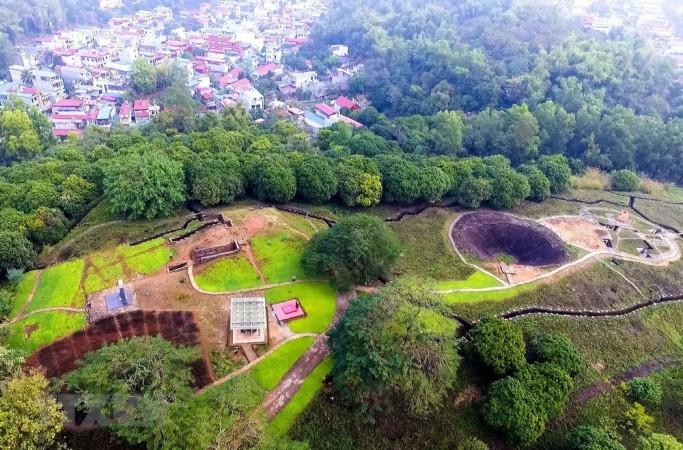
Dien Bien Phu Battlefield - © Vietnam Finance Magazine
Must-Try Dishes in Dien Bien
Dien Bien’s culinary heritage is a vibrant reflection of its rich cultural diversity, offering travelers a unique opportunity to savor the flavors of Northwest Vietnam. The local cuisine is characterized by fresh, natural ingredients, often sourced from the surrounding mountains and forests, and traditional cooking techniques passed down through generations.
- Thang Co: A traditional Hmong stew made from horse meat, bones, and organs, slow-cooked with a blend of herbs and spices. This hearty dish is a staple at festivals and gatherings, offering a rich, earthy flavor that is deeply rooted in the local culture.
- Xoi Nep: Sticky rice, a staple in Dien Bien, comes in various forms, with Xoi Nep being one of the most popular. Often steamed with local herbs, Xoi Nep is commonly served with grilled meats or enjoyed on its own as a comforting, simple dish.
- Pa Pinh Top: This is a signature dish of the Thai people, featuring grilled fish marinated with herbs, wrapped in banana leaves, and cooked over an open flame. The result is a fragrant and flavorful dish that perfectly captures the essence of traditional Thai cooking.
- Canh Bon: A comforting soup made from young bamboo shoots, often cooked with pork or chicken. The bamboo shoots give the soup a slightly sweet, tender texture, making it a popular dish, especially during the cooler months.
- Mang Dang: Bitter bamboo shoots are a specialty in Dien Bien. Mang Dang is often grilled, stir-fried, or boiled, and is known for its distinct, slightly bitter taste that pairs well with rice and other savory dishes.
- Cha Nhai: A dish made from field frogs, Cha Nhai is a local delicacy where the frogs are minced, seasoned, and formed into patties before being grilled or fried. It's a distinctive meal that showcases the region's culinary inventiveness and ingenuity.
Craving Vietnamese cuisine? Discover the old capital of Vietnam, Hue, the city that famous for its unique and tasty dishes, here.

Dien Bien Sticky Rice (Xoi Nep) - © CafeF
Festivals & Local Celebrations
Dien Bien Phu Victory Festival
The Dien Bien Phu Victory Festival, held annually in May, is the most significant celebration in the region. It commemorates the historic victory of Vietnamese forces over the French in 1954. The festival is marked by a series of events, including parades, reenactments, traditional music performances, and fireworks. This is a time when the entire province comes alive with pride and festivity, offering visitors a unique opportunity to witness and partake in the celebrations.
Ethnic Minority Festivals
In addition to the Victory Festival, Dien Bien is home to various ethnic minority festivals that reflect the rich cultural tapestry of the region. Two notable examples include:
- Thai New Year (Bun Pi May): Celebrated by the Thai people, Bun Pi May is the Thai New Year festival, usually held in mid-April, marking the start of the new year according to the Thai lunar calendar. The celebration is well-known for its water-splashing customs, which stand for cleansing and the removal of misfortune.
- Hmong New Year: The Hmong New Year, celebrated by the Hmong community in December, is a time for giving thanks, honoring ancestors, and seeking blessings for the coming year. This festival coincides with the end of the harvest season, making it a time of abundance and gratitude. A highlight of the festival is the Keo Khen, a dance performed to the sound of bamboo flutes, showcasing the agility and skill of the dancers.
- Xen Pang Festival (Worshiping the Village Deity): The Xen Pang Festival, also known as the Worshiping the Village Deity festival, is an important event for the Tày and Nùng ethnic groups in Dien Bien. This festival, typically held in the spring, is a form of ancestral worship where the community prays for a bountiful harvest, health, and prosperity.
- Kho Cum Festival: The Kho Cum Festival, celebrated by the Kho Mu ethnic group, was held after the harvest. This festival is a time for thanksgiving and merriment. Traditional drum and gong performances are included there; it is believed that the beat and rhythm may connect with the ghosts of the ancestors.
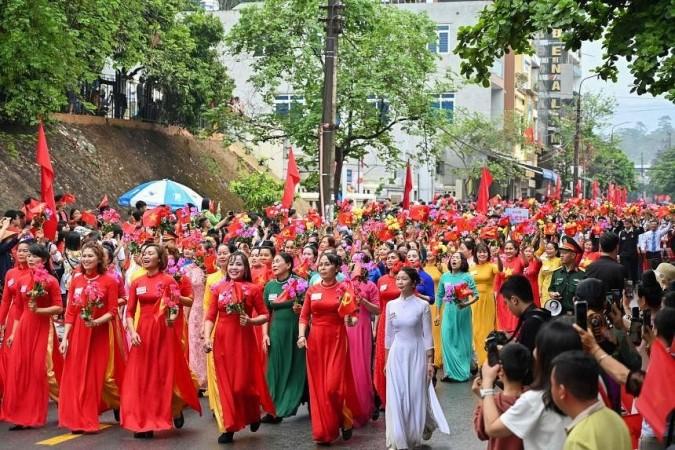
Dien Bien Phu Victory Festival - © The Straits Times
What to Do in Dien Bien
Outdoor Adventures in Dien Bien
- Trekking routes in Dien Bien: The mountainous terrain and lush forests of Dien Bien are perfect for trekking. Popular trails include routes around Muong Phang National Park and the area surrounding Pa Khoang Lake.
- Cave Exploration: Dien Bien is dotted with numerous caves, many of which remain largely unexplored. Visitors can join guided tours to discover these hidden gems, learning about the region’s geology and history along the way.
- Dien Bien Cycling Tours: For those who prefer a slower pace, cycling through the valley offers breathtaking views of rice paddies, rivers, and local villages, all set against a backdrop of majestic mountains.
Cultural Tours in Dien Bien
- Guided Historical Tours: Explore the key sites of the Battle of Dien Bien Phu with knowledgeable guides who can provide detailed insights into the events that shaped this region.
- Village Tours: Visit local villages where you can interact with residents, learn about traditional crafts, and even participate in daily activities such as farming or cooking.
Shopping in Dien Bien
Dien Bien Local Markets
- Dien Bien Phu Market: The largest market in the area, offering everything from fresh produce to traditional clothing, handicrafts, and souvenirs. This market is an excellent place to find handmade textiles, silver jewelry, and other unique items that make for memorable keepsakes.
- Muong Thanh Market: Known for its selection of traditional Thai and Hmong clothing, as well as locally grown herbs and spices. This market is a bit smaller but offers a more intimate shopping experience.
What to Buy in Dien Bien
- Handwoven Textiles: The Thai and Hmong people are known for their intricate weaving techniques, producing beautiful textiles that are often used for clothing, blankets, and bags.
- Silver Jewelry: Hmong silver jewelry is another popular item, known for its detailed craftsmanship and cultural significance.
- Local Spices: For those who enjoy cooking, buying local herbs and spices allows you to bring a taste of Dien Bien home with you.
- Bamboo and Wood Carvings: Handcrafted items made from bamboo and wood, often featuring traditional designs and motifs.
- Embroidery and Sewing Products: Items such as embroidered bags, tablecloths, and wall hangings showcase the intricate needlework skills of the local communities.

Handmade Embroidery and Sewing Products in Dien Bien - © VnBusiness
Weather in Dien Bien: Best Time to Visit
Dien Bien experiences a tropical climate with distinct seasons that impact travel plans. Understanding the weather conditions can help you make the most of your visit.
- Spring in Dien Bien: Dien Bien's springtime is marked by comfortable weather and blossoming flowers. This is a great time of year to explore the area's natural splendor and engage in outdoor activities.
- Summer in Dien Bien: Summer brings warmer temperatures and higher humidity, with occasional rain showers. This is the peak season for trekking and exploring the lush landscapes, but be prepared for rain and heat.
- Autumn in Dien Bien: Autumn offers cooler temperatures and clear skies, making it a great time for sightseeing and cultural activities. The weather is generally pleasant, with less rainfall and comfortable temperatures.
- Winter in Dien Bien: Winter is cooler, especially in the higher altitudes, with temperatures dropping significantly. It’s a good time for experiencing local festivals and enjoying the crisp, fresh air.
Culture Etiquette in Dien Bien
Understanding local customs and etiquette is crucial for respectful and enjoyable interactions with the people of Dien Bien.
- Dress Modestly: When visiting local villages or participating in cultural events, dress modestly. Traditional attire is often worn by locals, and it’s respectful to dress in a way that shows consideration for local customs.
- Respect Traditions: Participate in local customs with sensitivity and respect. For example, when attending religious ceremonies or festivals, follow the lead of local participants and observe their practices respectfully.
- Greetings and Communication: A friendly smile and a polite greeting are appreciated. In many ethnic communities, a nod or handshake is a common form of greeting. Be mindful of local customs regarding physical contact and personal space.
- Ask for Permission: Always ask for permission before taking photos of people or their property. Respecting privacy is an important part of cultural etiquette.
- Gift Giving: It is customary to offer a modest gift as a sign of thanks when you are welcomed to someone's house. Traditional items or local products make thoughtful gifts.
As an Asian country, Vietnam has many cultural etiquette that it is better to follow. However, different areas have their own unique etiquette, check out our article about Ho Chi Minh City here.
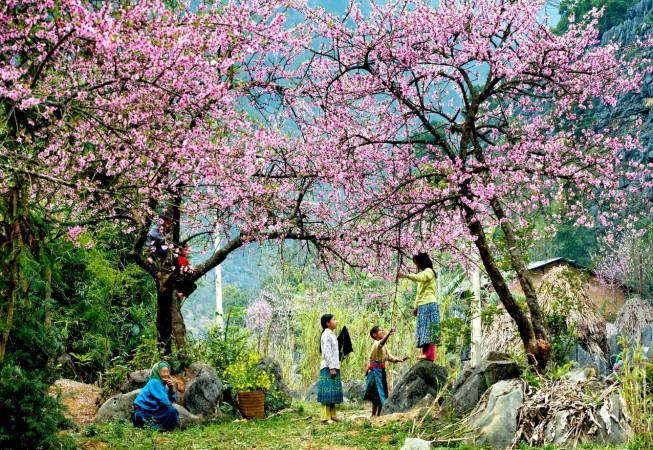
Spring in Dien Bien - © ToQuoc
Essential Travel Information
Getting Around Dien Bien
- Local Buses: Buses are a common and affordable way to travel within Dien Bien and between cities. They offer routes to major attractions and local areas, though they may not be as frequent or comfortable as other options. There are comfortable direct sleeper buses from Hanoi to Dien Bien.
- Motorbike Rentals: Renting a motorbike is a popular choice for independent travelers who want the flexibility to explore Dien Bien at their own pace. Motorbike rentals are widely available in Dien Bien Phu city and nearby towns.
- Taxis and Ride-Sharing: Taxis are available in Dien Bien Phu city, and ride-sharing apps may offer additional convenience. Taxis are a reliable way to get around the city and reach specific destinations.
- Car Rentals: For those seeking more comfort and flexibility, renting a car with or without a driver is an option. This allows you to explore Dien Bien’s attractions and scenic routes at your leisure.
- Cycling: Biking is an excellent way to explore the local scenery and enjoy the natural beauty of Dien Bien. Many guesthouses and hotels offer bike rentals, and cycling through the valley or along scenic routes is a rewarding experience.
ATM & Banking Services
In Dien Bien Phu, the main city in Dien Bien province, you’ll find several ATMs offering basic services like cash withdrawals and balance inquiries. While ATMs are readily available in the city center, they become less frequent in rural areas, so it's advisable to carry sufficient cash when traveling outside the city. Banking services, including currency exchange and account management, are provided by various banks located centrally. To avoid issues, carry enough cash, use ATMs during daylight hours, and notify your bank of your travel plans to ensure your cards function properly abroad.
Where to Stay in Dien Bien
- Luxury Hotels: For a comfortable stay with premium amenities, high-end hotels in the city offer spacious rooms, modern facilities, and often feature dining options, fitness centers, and business services.
- Mid-Range Hotels: Well-rated mid-range hotels provide a balance of comfort and affordability. These options offer clean rooms, good service, and convenient locations close to major attractions.
- Budget Hotels: Budget-conscious travelers can find a variety of affordable guesthouses and hotels. These establishments offer basic amenities and comfortable accommodations at economical rates.
- Local Homestays: In the Thai villages, homestays offer insight into Thai culture and traditions, including traditional meals and cultural activities. Similarly, staying with a Hmong family provides a chance to experience Hmong customs, crafts, and daily life firsthand.
Articles for you

Explore Yala National Park - Sri Lanka Travel, Asia
Tucked away in Sri Lanka’s southeastern corner, Yala National Park is where wild nature meets deep tradition. Known worldwide for its leopard population, the park is also home to elephants, sloth bears, crocodiles, and hundreds of bird species. Beyond wildlife, Yala opens doors to a cultural landscape dotted with ancient temples, Buddhist ruins, and coastal villages. For travelers seeking more than just a safari, Yala offers a chance to explore eco-tourism, local communities, and sacred heritage sites.
Population: The Yala National Park area doesn’t have a human population.
Economy: The economy around Yala National Park thrives on a blend of eco-tourism, agriculture, and local services. Safari tours, eco-lodges, and cultural experiences drive steady income for nearby towns like Tissamaharama and Kataragama, supporting thousands of families.
Landmarks: Famous for Block I of Yala and wildlife encounters, including elephants, sloth bears, crocodiles, and exotic bird species.

Explore Galle - Sri Lanka Travel, Asia
Nestled on Sri Lanka’s southern coastline, Galle is a vibrant city where history meets the sea. Its cobbled streets, colonial architecture, and serene beaches make it a must-visit destination for travelers seeking a blend of culture, adventure, and relaxation. A UNESCO World Heritage site, Galle captivates visitors with its Dutch Fort, bustling markets, and friendly locals. Whether you’re exploring the ramparts at sunset or savoring fresh seafood by the shore, Galle promises an unforgettable journey into Sri Lanka’s heritage.
Population: Approximately 113,000 in 2023.
Economy: Galle’s economy thrives on tourism, trade, and fisheries. The city’s historic fort, colonial architecture, and coastal charm draw thousands of international visitors each year, making tourism its main economic driver. Fishing remains vital for local livelihoods, supplying fresh seafood across the region.
Landmarks: Famous for the Galle Fort, Dutch Reformed Church & Maritime Museum, and Unawatuna Beach.

Explore Bentota - Sri Lanka Travel, Asia
Nestled along Sri Lanka’s southwestern coast, Bentota is a tropical paradise that blends golden beaches, vibrant culture, and thrilling adventures. Famous for its calm waters, luxury resorts, and scenic river estuary, Bentota has become a top destination for travelers seeking both relaxation and authentic experiences. From serene beach walks at sunrise to adrenaline-pumping water sports, this coastal town offers a perfect balance of leisure and exploration. With its proximity to Colombo and Galle, Bentota is easy to reach, making it an ideal stop for both short escapes and extended holidays.
Population: Approximately 37,000 in 2023.
Economy: Bentota’s economy thrives mainly on tourism, which drives local businesses such as hotels, restaurants, and wellness retreats. The town also benefits from fishing, coconut cultivation, and handicrafts like wood carving and batik textiles. Many residents rely on the growing demand for water sports and Ayurvedic treatments, making tourism the backbone of both income and employment in the area.
Landmarks: Famous for Bentota Beach, Bentota River Safari, and Kande Vihara Temple.

Explore Mirissa - Sri Lanka Travel, Asia
Mirissa is a charming coastal town on Sri Lanka’s southern shoreline. Known for its golden beaches, turquoise waters, and vibrant marine life, it has become a must-visit stop for travelers exploring the island. Many come for whale watching, surfing, and sunset views at Coconut Tree Hill, but Mirissa offers much more than postcard beauty. The fishing boats you see anchored by the bay carry generations of stories. Local traditions, delicious cuisine, and a laid-back rhythm of life shape every visitor’s experience.
Population: Approximately 4,700 in 2023.
Economy: Mirissa’s economy is largely shaped by its coastal location. Fishing has long been the backbone of local livelihoods, with generations relying on the Indian Ocean for income. In recent decades, tourism has become the main driver of growth, thanks to whale watching, surfing, and beachside hospitality.
Landmarks: Famous for Mirissa Beach, Coconut Tree Hill, and Parrot Rock Bridge.

Explore Nuwara Eliya - Sri Lanka Travel, Asia
Tucked away in the Central Highlands of Sri Lanka, Nuwara Eliya is often called “Little England”. With its rolling tea plantations, cool misty mornings, and colonial charm, this mountain town feels like a step into another world. Travelers come here to breathe fresh air, walk through flower gardens, sip the finest Ceylon Tea, and enjoy a pace of life far from the island’s busy cities. Whether you’re drawn by scenic landscapes, heritage architecture, or the warmth of its people, Nuwara Eliya is a destination that blends nature, culture, and history in perfect harmony.
Population: Approximately 781,000 in 2023.
Economy: Nuwara Eliya’s economy thrives mainly on tea production, as it sits in the heart of Sri Lanka’s central highlands, famous worldwide for Ceylon Tea. The city also benefits from a growing tourism industry, attracting visitors with its colonial charm, cool climate, and scenic landscapes.
Landmarks: Famous for Gregory Lake, Hakgala Botanical Garden, and Victoria Park.

Explore Sukau - Malaysia Travel, Asia
Nestled on the banks of the Kinabatangan River in Sabah, Malaysian Borneo, Sukau is a destination where wildlife, culture, and conservation come together. Known as one of Asia’s top spots for river safaris and eco-tourism, this quiet village offers a front-row seat to encounters with Bornean orangutans, pygmy elephants, proboscis monkeys, and exotic birdlife.
Population: Approximately 1,400 in 2019.
Economy: Sukau’s economy is shaped by its riverine location and natural resources. Traditionally, the Orang Sungai community relied on fishing, small-scale farming, and forest gathering for their livelihood. Today, the village has shifted toward eco-tourism, with river cruises, jungle trekking, and homestays providing income.
Landmarks: Famous for the Kinabatangan River cruises, Gomantong Caves, and Ox-bow lakes and wetlands.
